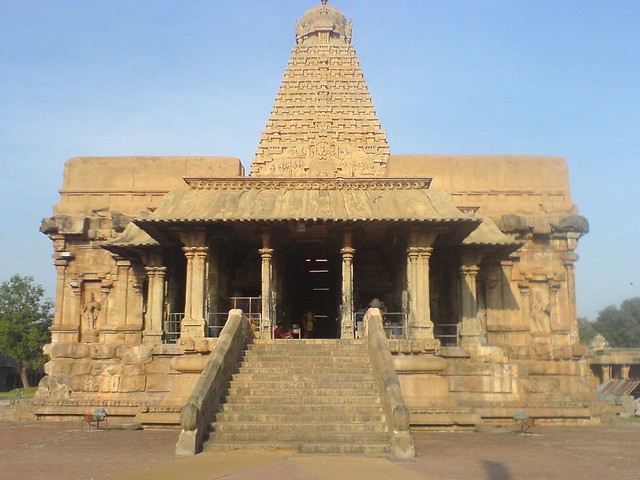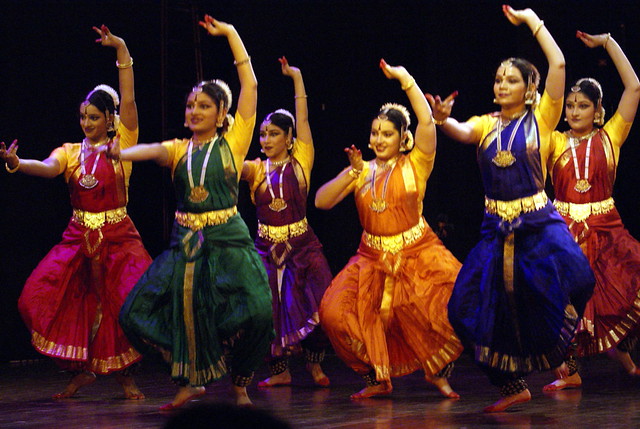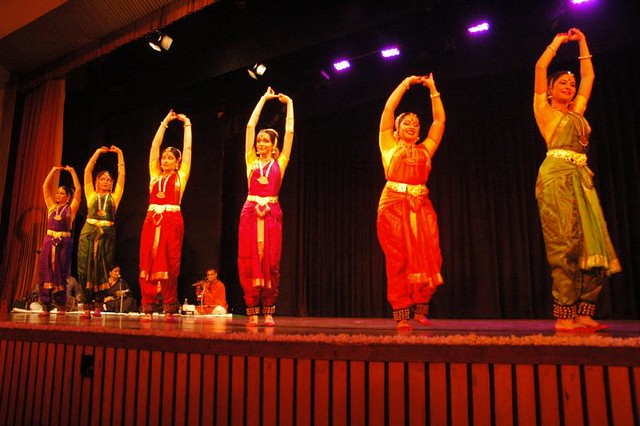Brhan-Natya-Yagna- September 25, 2010 Thanjavur
Special program featuring 1000 dancers at the Brihadeeswara Temple
more
Association of Bharatanatyam Artistes of India (ABHAI), plan to conduct BRHAN - NATYA - YAGNA, a grand offering by 1000 dancers to commemorate the
1000th year of the Brihadeeswara Temple, the world's first complete granite temple at Thanjavur.
The 1000 artistes will jointly pay obeisance to Brihadeeswara and Raja Raja Cholan by performing together on the evening of 25th September 2010, in the temple premises.
Purpose: To kindle an awareness among dancers about the connection between the temple and the dancers in olden times. It is a BRHAN-NATYA YAGNA - a grand offering by dancers to pay obeisance to Lord Brihadeeswara and to show their gratitude to the great king Raja Raja Chola, on the completion of 1000 years of the Brihadeeswara temple.
The Brihadeeswarar Temple

The Brihadeeswarar Temple or Peruvudaiyar Kovil, also known as Rajarajeswaram, at Thanjavur in Tamil Nadu, is the world's first complete granite temple. It is a brilliant example of the artistry and architecture of the Vishwakarmas in temple architecture. It is a tribute and a reflection of the power of its patron Rajaraja Chola I. It is one of the greatest glories of Indian architecture and is one of our most prized architectural sites. The temple is part of the UNESCO World Heritage Site of the "Great Living Chola Temples."
The foundations of the temple were laid out by the Tamil Emperor Arulmozhivarman, popularly called Rajaraja Chola I, in 1002 CE, as the first of the great Tamil Chola building projects. According to tradition, the temple was built by the Chola king Rajaraja in compliance of a command given to him in his dream. The Vimaana or the temple tower is 216 ft (66 m) high and is among the tallest of its kind in the world.
The great Brihadeeswara Temple was completed around 1010 AD. It remained the centre of the Chola administration for many years, channeling the state revenue into a number of civic projects. It also acted as a repository of the empire's records, as the great Rajaraja had its walls covered with numerous inscriptions recording his conquests and his endowments to various charities. The impression we get from the inscriptions is of a wealthy, progressive city, although totally dominated by the temple.
This temple is a unique monument in many respects.
It attracts the curiosity of not merely the historian but also the sociologist, not to speak of the dancer and the painter for it is perhaps the only temple in the world which carries on its walls, the engraved evidence, in beautiful calligraphy, of its entire history and the story of the contemporary society. Such an exhaustive documentation ranging over almost a hundred long inscriptions engraved on the walls, pillars and podium, is rare wealth indeed, of immeasurable value to the scholar. The inscriptions give, apart from a comprehensive history of the times, a full enumeration of all the metallic images set up in the temple. Numbering about 66, these icons are referred to with a description of the minutest details of size, shape and composition. This alone is a mine of information for the art historian.
The temple also sports a depiction in stone, of 81 of the 108 karanas of Bharata Muni's ‘Natya Sastra' - the first of its kind - setting the pace for many others to follow in succeeding centuries. The inscriptional data also abound in mention of the jewellery of the period; about 66 different types of ornaments, jewellery and the names of 400 dancers who were attached to the temple. The Temple is a veritable source of invaluable material on the social and cultural life of the people of the times.
Bharata Natyam

Bharata Natyam is one of the oldest dance forms of India. It was nurtured in the temples and courts of southern India since ancient times. Later it was codified and documented as a performing art in the 19th century by four brothers known as the Tanjore Quartet whose musical compositions for dance form the bulk of the Bharata Natyam repertoire even today. The art was handed down as a living tradition from generation to generation under the Devadasi system under which women were dedicated to temples to serve the deity as dancers and musicians forming part of the elaborate rituals. These highly talented artists and the male gurus (nattuvanars) were the sole repository of the art until the early 20th century when a renewal of interest in India's cultural heritage prompted the educated elite to discover its beauty.
The legend and the inspiration

Bharatanatyam has a divine origin. Devas asked Brahma to create a Veda that would be understood by the Sudras, as Kali Yuga was nearing: "When the universe was overcome by desire, greed, jealousy and anger, when people became slaves of pleasure and pain, Brahma was moved to create a form of entertainment seen and heard and understood by everybody at the same time, as people could no longer understand the mystic and ambiguous scriptures".
Bharata natyam was created "not merely for pleasure, but to embody the cosmic relationshios and expressions (bhava) for all the worlds. So this performing art follows the worlds' movements in all activities and states: work and leisure, calm and laughter, fight and wars. It will confer righteousness onto the righteous, a moral restraint for the unruly, and discipline for the those who are guided by rule. It will teach wisdom both to the ignorant and the learned. It will provide entertainment for kings, and it will console the miserable ones. Natya will express all the moods and passions of the soul. It will incorporate all kinds of the deeds: the noble, the mediocre and the mean"

Thus Brahma created the the Fifth (Panchama) Veda, or NatyaVeda, a quintessence of the main four Vedas, by combining Pathya (words) of Rigveda, Abhinaya (communicative elements of the body movements, cf. mime) of Yajurveda, geetham (music and chant) of Samaveda, and rasam (vital sentiment and emotional element) of Atharvaveda. Then Brahma handed NatyaVeda to rishi Bharata to write it down and spread it in the material world. Bharata-guided the demigods (Gandharavas and Apsaras) in performing natya, nrtta and nrtya before Shiva. Natya Shastra came to be the fundamental authority on the technique of classical Indian dances, especially Bharatanatyam and Odissi, as well as Kuchipudi and Mohiniattam. Some prefer to belive the term "Bharatnatyam" owes its name to rishi Bharata.
Bharata along with the apsaras and gandharvas performed Bharatanatyam for Shiva who asked Thandu Maharishi to develop it further into a Thandava (which only much later came to mean "masculine") style of dance, the Cosmic Dance of Shiva. Shiva imparted Lasya Natya to Parvathi who taught it on to Usha (the daughter of Banasura). Usha passed it on to the gopis of Dwarka who then taught the women of Sowrashtra.
 The 1000 dancers will dance on the medai (platform) around the Nandi.
The 1000 dancers will dance on the medai (platform) around the Nandi.








 Reply With Quote
Reply With Quote

Bookmarks